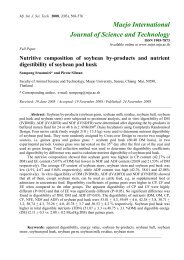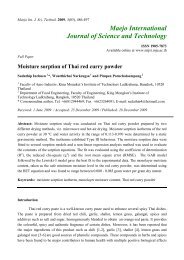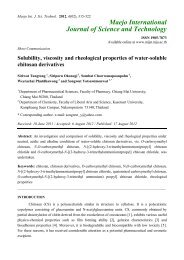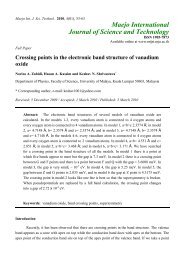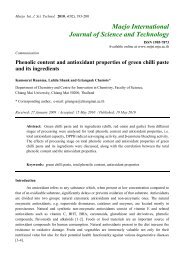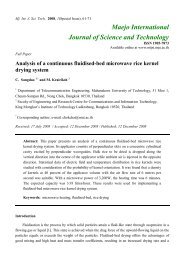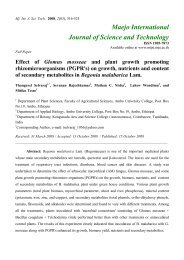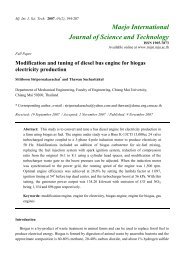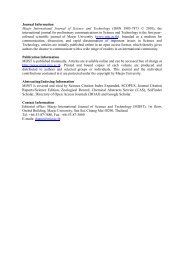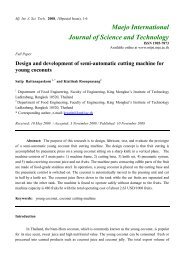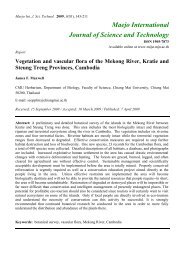ISSN 1905-7873 © 2012 - Maejo International Journal of Science ...
ISSN 1905-7873 © 2012 - Maejo International Journal of Science ...
ISSN 1905-7873 © 2012 - Maejo International Journal of Science ...
Create successful ePaper yourself
Turn your PDF publications into a flip-book with our unique Google optimized e-Paper software.
2 <strong>Maejo</strong> Int. J. Sci. Technol. <strong>2012</strong>, 6(01), 1-11<br />
health and are now used for supplementary food and animal feed. Previous studies have suggested<br />
that they can prevent or delay cancer and degenerative diseases in humans and animals by<br />
contributing to antioxidative defenses against metabolic oxidative by-products [9-11].<br />
Mass cultivation <strong>of</strong> algae in canteen wastewater for use as feed for Mekong giant catfish [2]<br />
and Tuptim tilapia [12] had been done. It was found that the algal biomass production strongly<br />
correlated with water quality and environmental factors, e.g. temperature, light intensity and nutrient<br />
concentration, results which were similarly obtained elsewhere [13-15]. However, several researches<br />
have indicated that phosphorus is a main factor related to growth and production <strong>of</strong> Cladophora<br />
[13-24]. Other researches have also shown that phosphorus is effective for algal carotenoid and<br />
chlorophyll production [25-30]. In contrast, stimulation <strong>of</strong> carotenoid and chlorophyll production<br />
with phosphorus starvation has been reported [31-35].<br />
Culturing <strong>of</strong> algae in wastewater can also improve the water quality by decreaseing BOD,<br />
COD and nutrients <strong>of</strong> the wastewater [2,12,36]. In this research, mass cultivation <strong>of</strong> Cladophora sp.<br />
(Kai) in canteen wastewater with different phosphate concentrations was carried out to investigate<br />
the effects <strong>of</strong> supplementary phosphorus on carotenoid and chlorophyll content <strong>of</strong> this alga, its<br />
biomass production and physico-chemical characteristics <strong>of</strong> the culture water.<br />
MATERIALS AND METHODS<br />
Culture Media Preparation<br />
One thousand litres <strong>of</strong> canteen wastewater were collected from the canteen wastewater<br />
clarifier <strong>of</strong> <strong>Maejo</strong> University and left to settle in an open cement pond for 3 weeks to allow<br />
microorganisms to break down solid organic waste. The wastewater was then filtered through an 80-<br />
m plankton net filter [36]. The filtrate was diluted to 10% and analysed for pH, dissolved oxygen<br />
(DO), biochemical oxygen demand (BOD), total hardness, ammonia-nitrogen (NH 3 -N), nitratenitrogen<br />
(NO 3 - -N), nitrite-nitrogen (NO 2 - -N), total Kjeldal nitrogen (TKN) and orthophosphatephosphorus<br />
(PO 4 3- -P) by following the methods <strong>of</strong> APHA et al [37].<br />
Culture Condition<br />
Cladophora sp. (Kai) was obtained from the Algae and Water Quality Research Unit, Chiang<br />
Mai University. The alga was cultured for 12 weeks at ambient air temperature (21-28 o C) and light<br />
intensity (12,333-39,267 lux) by attachment on plastic nets (60 g m -2 ) in cement raceway ponds (size<br />
1.2×2.3×0.5 m) each containing diluted canteen wastewater 20 cm deep (552 L per experiment) with<br />
continuous pump-driven circulation <strong>of</strong> 0.15 m s -1 [2,4]. A complete randomised design (CRD) was<br />
carried out with addition <strong>of</strong> dipotassium hydrogen orthophosphate (K 2 HPO 4 ) at concentrations <strong>of</strong> 5,<br />
10, 15 and 20 mg L -1 (treatment 1, 2, 3 and 4 respectively) with diluted canteen wastewater without<br />
K 2 HPO 4 as control. The experiment was done in triplicate.<br />
Carotenoid and Chlorophyll Analysis<br />
The alga at 12 weeks <strong>of</strong> culturing was harvested, washed with tap water, air dried and freezedried.<br />
The total carotenoid content was determined according to the method <strong>of</strong> Britton [38]. The<br />
freeze-dried sample (0.4 g) was homogenised with 20 mL <strong>of</strong> 95% ethanol in an extraction tube. Two




